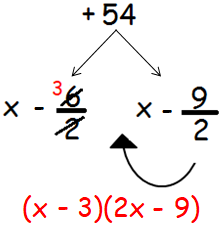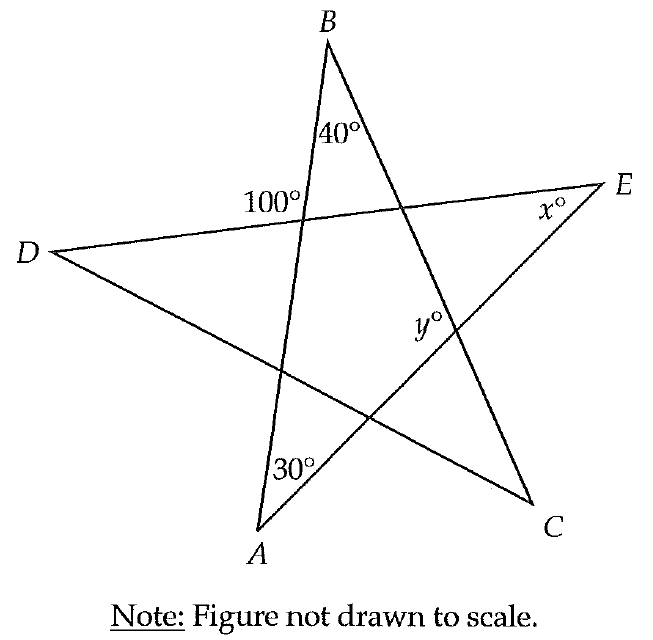SOLVING QUADRATIC EQUATIONS BY FACTORING EXAMPLES
Generally we have two types of quadratic equation.
- Quadratic equation of leading coefficient 1.
- Quadratic equation of leading coefficient not equal to 1.
The general form of a quadratic equation is
ax2 + bx + c = 0
In a quadratic equation, leading coefficient is nothing but the coefficient of x2.
Solving Quadratic Equations by Factoring with a Leading Coefficient of 1 - Procedure
(i) In a quadratic equation in the form ax2 + bx + c = 0, if the leading coefficient is 1, we have to decompose the constant term "c" into two factors.
(ii) The product of the two factors must be equal to the constant term "c" and the addition of two factors must be equal to the coefficient of x, that is "b".
(iii) If p and q are the two factors of the constant term c, then we have to factor the quadratic equation using p and q as shown below.
(x + p)(x + q) = 0
(iv) Solving the above equation, we get
x = -p and x = -q
How to assign signs for the two factors ?
|
Quadratic Equation |
Signs of Factors |
|
ax2 + bx + c = 0 |
Positive sign for both the factors. |
|
ax2 - bx + c = 0 |
Negative sign for both the factors. |
|
ax2 + bx - c = 0 |
Negative sign for smaller factor and positive sign for larger factor. |
|
ax2 - bx - c = 0 |
Positive sign for smaller factor and negative sign for larger factor. |
Solving Quadratic Equations by Factoring when Leading Coefficient is not 1 - Procedure
(i) In a quadratic equation in the form ax2 + bx + c = 0, if the leading coefficient is not 1, we have to multiply the coefficient of x2 and the constant term. That is "ac". Then, decompose "ac" into two factors.
(ii) The product of the two factors must be equal to "ac" and the addition of two factors must be equal to the coefficient of x, that is "b".
(iii) Divide the two factors by the coefficient of x2 and simplify as much as possible.
(iv) Write the remaining number along with x (This is explained in the following example).
Example 1 :
Solve for x :
x2 + 9x + 14 = 0
Solution :
In the given quadratic equation, the coefficient of x2 is 1.
Decompose the constant term +14 into two factors such that the product of the two factors is equal to +14 and the addition of two factors is equal to the coefficient of x, that is +9.
Then, the two factors of +14 are
+2 and +7
Factor the given quadratic equation using +2 and +7 and solve for x.
(x + 2)(x + 7) = 0
x + 2 = 0 or x + 7 = 0
x = -2 or x = -7
So, the solution is {-2, -7}.
Example 2 :
Solve for x :
x2 - 9x + 14 = 0
Solution :
In the given quadratic equation, the coefficient of x2 is 1.
Decompose the constant term +14 into two factors such that the product of the two factors is equal to +14 and the addition of two factors is equal to the coefficient of x, that is -9.
Then, the two factors of +14 are
-2 and -7
Factor the given quadratic equation using -2 and -7 and solve for x.
(x - 2)(x - 7) = 0
x - 2 = 0 or x - 7 = 0
x = 2 or x = 7
So, the solution is {2, 7}.
Example 3 :
Solve for x :
x2 + 2x - 15 = 0
Solution :
In the given quadratic equation, the coefficient of x2 is 1.
Decompose the constant term -15 into two factors such that the product of the two factors is equal to -15 and the addition of two factors is equal to the coefficient of x, that is +2.
Then, the two factors of -15 are
+5 and -3
Factor the given quadratic equation using +5 and -3 and solve for x.
(x + 5)(x - 3) = 0
x + 5 = 0 or x - 3 = 0
x = -5 or x = 3
So, the solution is {-5, 3}.
Example 4 :
Solve for x :
x2 - 2x - 15 = 0
Solution :
In the given quadratic equation, the coefficient of x2 is 1.
Decompose the constant term -15 into two factors such that the product of the two factors is equal to -15 and the addition of two factors is equal to the coefficient of x, that is -2.
Then, the two factors of -15 are
+3 and -5
Factor the given quadratic equation using +3 and -5 and solve for x.
(x + 3)(x - 5) = 0
x + 3 = 0 or x - 5 = 0
x = -3 or x = 5
So, the solution is {-3, 5}.
Example 5 :
Solve for x :
2x2 + 15x + 27 = 0
Solution :
In the given quadratic equation, the coefficient of x2 is not 1.
So, multiply the coefficient of x2 and the constant term "+27".
3 ⋅ (+27) = +54
Decompose +54 into two factors such that the product of two factors is equal to +54 and the addition of two factors is equal to the coefficient of x, that is +15.
Then, the two factors of +54 are
+6 and +9
Now we have to divide the two factors +6 and +9 by the coefficient of x2, that is 2.

(x + 3)(2x + 9) = 0
x + 3 = 0 or 2x + 9 = 0
x = -3 or x = -9/2
So, the solution is {-3, -9/2}.
Example 6 :
Solve for x :
2x2 - 15 x + 27 = 0
Solution :
In the given quadratic equation, the coefficient of x2 is not 1.
So, multiply the coefficient of x2 and the constant term "+27".
3 ⋅ (+27) = +54
Decompose +54 into two factors such that the product of two factors is equal to +54 and the addition of two factors is equal to the coefficient of x, that is +15.
Then, the two factors of +54 are
-6 and -9
Now we have to divide the two factors -6 and -9 by the coefficient of x2, that is 2.

(x - 3)(2x - 9) = 0
x - 3 = 0 or 2x - 9 = 0
x = 3 or x = 9/2
So, the solution is {3, 9/2}.
Example 7 :
Solve for x :
2x2 + 3x - 27 = 0
Solution :
In the given quadratic equation, the coefficient of x2 is not 1.
So, multiply the coefficient of x2 and the constant term "-27".
3 ⋅ (-27) = -54
Decompose -54 into two factors such that the product of two factors is equal to -54 and the addition of two factors is equal to the coefficient of x, that is +3.
Then, the two factors of -54 are
+9 and -6
Now we have to divide the two factors +9 and -6 by the coefficient of x2, that is 2.

(2x + 9)(x - 3) = 0
2x + 9 = 0 or x - 3 = 0
x = -9/2 or x = 3
So, the solution is {-9/2, 3}.
Kindly mail your feedback to v4formath@gmail.com
We always appreciate your feedback.
©All rights reserved. onlinemath4all.com
Recent Articles
-
Digital SAT Math Problems and Solutions (Part - 134)
Apr 02, 25 12:40 AM
Digital SAT Math Problems and Solutions (Part - 134) -
SAT Math Resources (Videos, Concepts, Worksheets and More)
Apr 02, 25 12:35 AM
SAT Math Resources (Videos, Concepts, Worksheets and More) -
Digital SAT Math Problems and Solutions (Part 135)
Apr 02, 25 12:32 AM
Digital SAT Math Problems and Solutions (Part 135)

